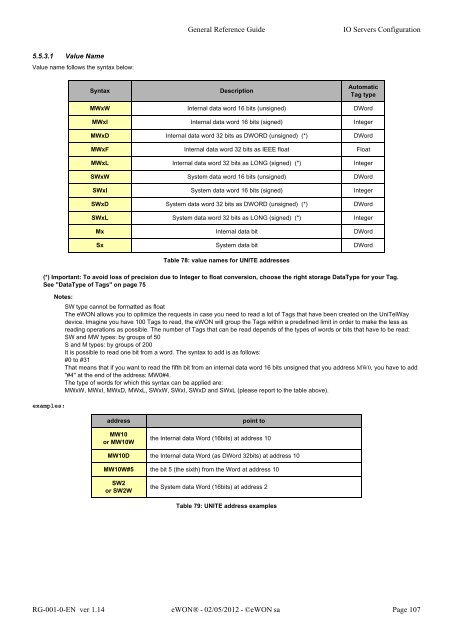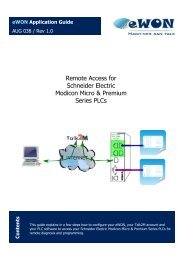eWON General Reference Guide - eWON wiki
eWON General Reference Guide - eWON wiki
eWON General Reference Guide - eWON wiki
Create successful ePaper yourself
Turn your PDF publications into a flip-book with our unique Google optimized e-Paper software.
5.5.3.1 Value Name<br />
Value name follows the syntax below:<br />
<strong>General</strong> <strong>Reference</strong> <strong>Guide</strong> IO Servers Configuration<br />
(*) Important: To avoid loss of precision due to Integer to float conversion, choose the right storage DataType for your Tag.<br />
See "DataType of Tags" on page 75<br />
examples:<br />
Syntax Description<br />
Automatic<br />
Tag type<br />
MWxW Internal data word 16 bits (unsigned) DWord<br />
MWxI Internal data word 16 bits (signed) Integer<br />
MWxD Internal data word 32 bits as DWORD (unsigned) (*) DWord<br />
MWxF Internal data word 32 bits as IEEE float Float<br />
MWxL Internal data word 32 bits as LONG (signed) (*) Integer<br />
SWxW System data word 16 bits (unsigned) DWord<br />
SWxI System data word 16 bits (signed) Integer<br />
SWxD System data word 32 bits as DWORD (unsigned) (*) DWord<br />
SWxL System data word 32 bits as LONG (signed) (*) Integer<br />
Mx Internal data bit DWord<br />
Sx System data bit DWord<br />
Table 78: value names for UNITE addresses<br />
Notes:<br />
SW type cannot be formatted as float<br />
The <strong>eWON</strong> allows you to optimize the requests in case you need to read a lot of Tags that have been created on the UniTelWay<br />
device. Imagine you have 100 Tags to read, the <strong>eWON</strong> will group the Tags within a predefined limit in order to make the less as<br />
reading operations as possible. The number of Tags that can be read depends of the types of words or bits that have to be read:<br />
SW and MW types: by groups of 50<br />
S and M types: by groups of 200<br />
It is possible to read one bit from a word. The syntax to add is as follows:<br />
#0 to #31<br />
That means that if you want to read the fifth bit from an internal data word 16 bits unsigned that you address MW0, you have to add<br />
"#4" at the end of the address: MW0#4.<br />
The type of words for which this syntax can be applied are:<br />
MWxW, MWxI, MWxD, MWxL, SWxW, SWxI, SWxD and SWxL (please report to the table above).<br />
address point to<br />
MW10<br />
or MW10W<br />
the Internal data Word (16bits) at address 10<br />
MW10D the Internal data Word (as DWord 32bits) at address 10<br />
MW10W#5 the bit 5 (the sixth) from the Word at address 10<br />
SW2<br />
or SW2W<br />
the System data Word (16bits) at address 2<br />
Table 79: UNITE address examples<br />
RG-001-0-EN ver 1.14 <strong>eWON</strong>® - 02/05/2012 - ©<strong>eWON</strong> sa Page 107



